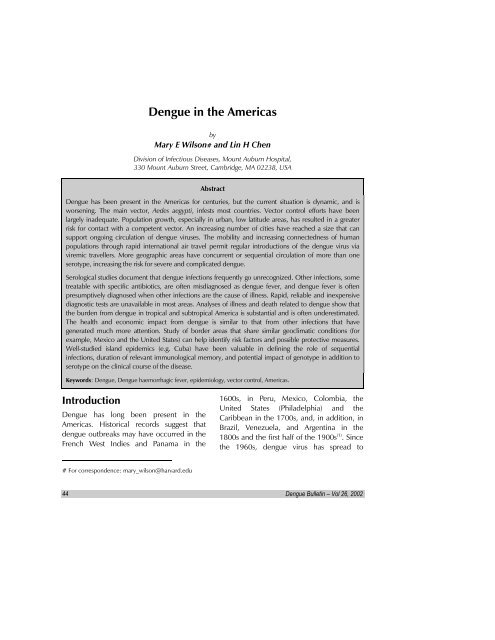Dengue Bulletin
Dengue Bulletin
Dengue Bulletin
- TAGS
- dengue
- bulletin
- 203.90.70.117
Create successful ePaper yourself
Turn your PDF publications into a flip-book with our unique Google optimized e-Paper software.
<strong>Dengue</strong> in the Americas<br />
by<br />
Mary E Wilson# and Lin H Chen<br />
Division of Infectious Diseases, Mount Auburn Hospital,<br />
330 Mount Auburn Street, Cambridge, MA 02238, USA<br />
Abstract<br />
<strong>Dengue</strong> has been present in the Americas for centuries, but the current situation is dynamic, and is<br />
worsening. The main vector, Aedes aegypti, infests most countries. Vector control efforts have been<br />
largely inadequate. Population growth, especially in urban, low latitude areas, has resulted in a greater<br />
risk for contact with a competent vector. An increasing number of cities have reached a size that can<br />
support ongoing circulation of dengue viruses. The mobility and increasing connectedness of human<br />
populations through rapid international air travel permit regular introductions of the dengue virus via<br />
viremic travellers. More geographic areas have concurrent or sequential circulation of more than one<br />
serotype, increasing the risk for severe and complicated dengue.<br />
Serological studies document that dengue infections frequently go unrecognized. Other infections, some<br />
treatable with specific antibiotics, are often misdiagnosed as dengue fever, and dengue fever is often<br />
presumptively diagnosed when other infections are the cause of illness. Rapid, reliable and inexpensive<br />
diagnostic tests are unavailable in most areas. Analyses of illness and death related to dengue show that<br />
the burden from dengue in tropical and subtropical America is substantial and is often underestimated.<br />
The health and economic impact from dengue is similar to that from other infections that have<br />
generated much more attention. Study of border areas that share similar geoclimatic conditions (for<br />
example, Mexico and the United States) can help identify risk factors and possible protective measures.<br />
Well-studied island epidemics (e.g. Cuba) have been valuable in defining the role of sequential<br />
infections, duration of relevant immunological memory, and potential impact of genotype in addition to<br />
serotype on the clinical course of the disease.<br />
Keywords: <strong>Dengue</strong>, <strong>Dengue</strong> haemorrhagic fever, epidemiology, vector control, Americas.<br />
Introduction<br />
<strong>Dengue</strong> has long been present in the<br />
Americas. Historical records suggest that<br />
dengue outbreaks may have occurred in the<br />
French West Indies and Panama in the<br />
# For correspondence: mary_wilson@harvard.edu<br />
1600s, in Peru, Mexico, Colombia, the<br />
United States (Philadelphia) and the<br />
Caribbean in the 1700s, and, in addition, in<br />
Brazil, Venezuela, and Argentina in the<br />
1800s and the first half of the 1900s (1) . Since<br />
the 1960s, dengue virus has spread to<br />
44 <strong>Dengue</strong> <strong>Bulletin</strong> – Vol 26, 2002









